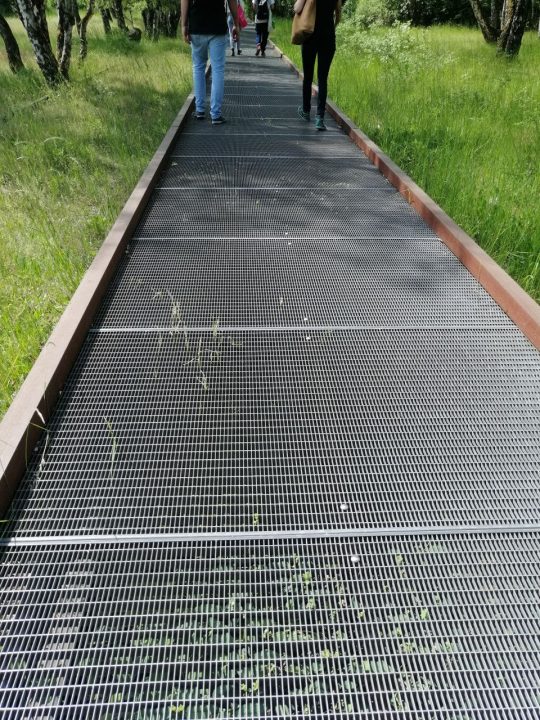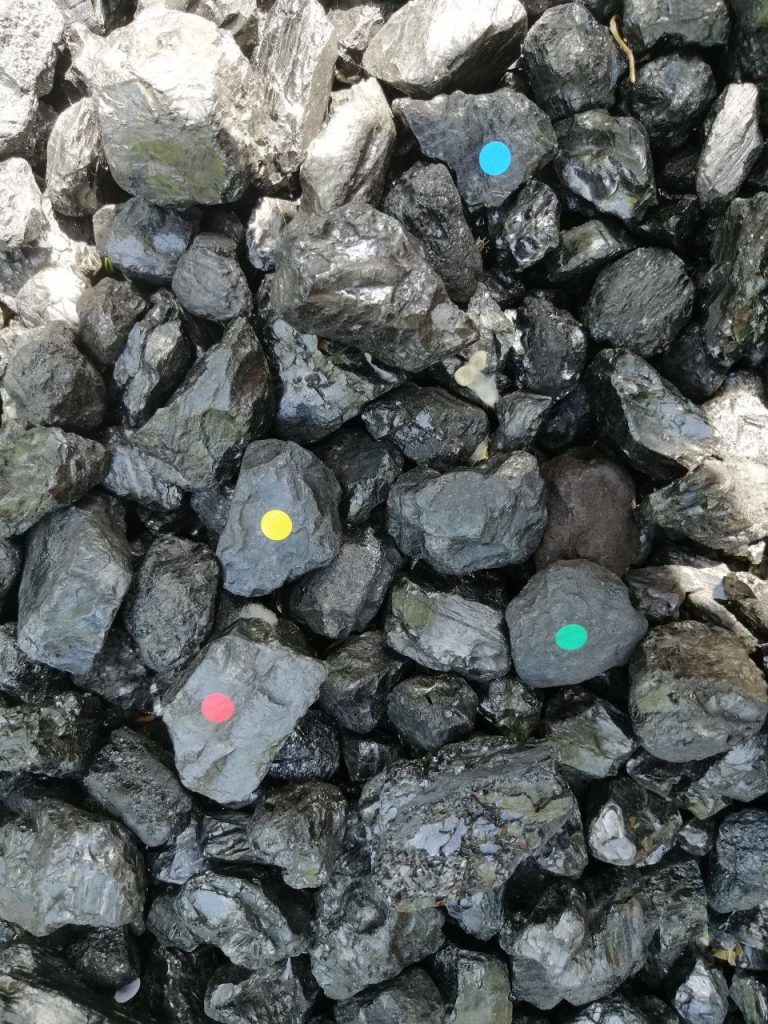Unruly Sites? Exploring the Brachen of Berlin – A Workshop by the Research Group of Environmental Anthropology

A lifeless machine sucks a symbolic Euro into its belly and we pass a stiff entry door into Naturpark Südgelände in Berlin. The slogan “Die Kunst ist der nächste Nachbar der Wildnis” greets from a warm yellow wall and behind we assume to find one of Berlin’s famous “Brachen”: a post-industrial ruin comprised of old train tracks overgrown by a forest and a manufacturing site turned into art space. But first we have to leave our bikes at a bike parking lot as we are harshly reminded by a “park official” wearing a vest. We – a group of four scientists from sociology, cultural geography, anthropology and landscape design – are about to explore an “unruly site”. Yet, only within the first meters we find rules to be ubiquitous. It seems that here nothing is left to chance – but isn’t this exactly what an unruly site is supposed to do?
The workshop “Exploring Unruly Sites of More-than-human Entanglements” organized by the research group “Environmental Anthropology” (DGSKA) at FU Berlin put the “Brache” – presumably ungoverned “ruderal worlds” (Stoetzer 2018) that emerge spontaneously in disturbed urban environments like brownfields, post-industrial ruins, cracks of sidewalks and along infrastructures – in the focus of their interest. Framing the Brache as “unruly site” the workshop invited participants to own explorations and provoked fierce discussion about how unruliness can be conceptualized and how a more-than-human approach helps to understand its boundaries and world-making qualities in an urban context heavily shaped by urban development and planning agendas, financialization as well as discourses of nature conservation. On the first day, presentations from a diverse array of perspectives in anthropology and human geography offered ethnographic insights from places all over the world and posed questions that set the stage. Katherine Sammler researching the granular geographies of Taranaki Maunga (Mt. Taranaki) in Aotearoa New Zealand asked: What does it mean to perceive a mountain as a category of knowledge? Where does a mountain begin, where are its boundaries and which boundary-making practices are enacted by whom? Cesár Giraldo Herrera presenting ethnographic observations on a fishing trawler in Northern Europe further troubled notions of nature-culture dichotomies: What can we learn from fishers gutting fishes about fishiness and its boundaries? How do perspectives and personhood of the fish and the fishers intertwine? Unruliness, we participants of the workshop quickly learned, necessitates addressing fundamental questions of boundary-making in the arena of contested nature-culture relations. When is a place its people, plants, infrastructures, its dynamics, presences and absences in a certain context unruly and how do moments of governance limit their unruliness? A screening of the documentary “Natura Urbana” by geographer Matthew Gandy positioned the Brache into the historical and contemporary socio-political context of Berlin with reference to the rubble women in post-second world war Germany as well as local biologists explorations of urban ruderal plant life and offered glimpses of the places to be explored later in the workshop. On the second day, small groups of participants finally went out to presumably unruly sites approaching them with the help of creative tools like threads and sticky dots handed out by the organizers. As the documentary showed, famous examples of presumably “unruly sites” in Berlin like Tempelhofer Feld, Prinzessinnengarten and Teufelsberg as well as less-known places like Naturpark Südgelände and Alter Bahnhof Siemensstadt had all been built or evolving on rubble, yet every group exploring them revealed different degrees of unruliness and boundary-setting governance at play. In a closing keynote Matthew Gandy gave an overview of different disciplinary approaches to urban nature juxtaposing the dominant systems-based approach with observational paradigms, urban political ecology and the ecological pluriverse synthesizing important but often contradictory perspectives to look at “Brachen” as unruly urban natures. While Gandys research and the “Brache” itself clearly trouble a neat nature-culture-dichotomy, conservation with a systems-based lens often draws borders between human culture and nonhuman nature although porous.
Centimeters of grass grow through the rusty looking metal walkway that hovers on the derelict train tracks for minimum human impact. Touching onto the more-than-human world appears not to be allowed even for a minimum of infrastructure, yet it had been even violently touched for industrial purposes long ago as we learn from one of many signs along the walkway telling of the history of the site. From signs explaining recent conservation efforts and the “ecosystem services” of bees and plants, we learn that only sheep are allowed to touch (or better: to eat) in order to manicure the unruly growth of grass. Life in this protected area of the Naturpark Südgelände can only thrive in its unruliness once the human visitors are made ruly. I can feel this process creeping onto my body, directing my gaze only up into canopies or towards lookouts built for the ruled gaze to assure itself of the neat unruliness of a desired growth and abundance. Culture watching nature or as we heard a park visitor call it the “the green world”, from a rusty metal outpost. We, inheriting the colonizers gaze, rarely lay down in the grass with our bellies touching ground and watching the creepiness of insects acting out their cultural geographies. We don’t want an ant to look down on us from the tower of our flesh and yet we are constantly watched by chirping birds hiding from our gaze in the canopies. As Barad once made clear, “the point is that the very practices of differentiating the “human” from the “nonhuman,” the “animate” from the “inanimate,” and the “cultural” from the “natural” produce crucial materializing effects” (Barad 2011: 124). And here I am, walking erect on a rusty materializing effect through which the unruliness of the grass grows. I, myself, feel ruled by this effect to the degree that it materializes in my directed gaze, my erected body. I can feel the energy effectively leaving my body, as I am deprived from interacting, from getting to know what surrounds me in my own way. I am bored. But then, as soon as we left the protected part of the Naturpark Südgelände and entered the open-air art exhibition reviving the derelict manufacturing complex, I remembered the colorful sticky dots that I picked from the workshop tool box. They came back into my mind while I starred at black coal spread out in front of me, an artistic means of reminding us of the park’s past. I pull out a blue dot sticking it to the piece of coal. Then a green, a yellow and a red one. I take a photograph and repeat this procedure with a neatly cut quadrant of green grass I presume to be the other part of the art piece. This time, I have a hard time sticking the dots. The grass surface appears to have an unruly materiality in their relation to the sticky dots. Finally, I managed to stick them to the grass, yet not in a way that is aligned with my aesthetical expectations. I take a photograph and leave.
Later this day, in discussions with the participants of the workshop on what an “unruly site” is supposed to be or do, I keep thinking of Karen Barad’s concept of intra-action emphasizing that relations between subjects exist prior to their boundaries. Relations actively shape a Brache into being. Unruly is not the site but rather its relational becoming. Once I brought the sticky dots into relation with the grass, their boundaries and “unruliness” formed. In the Q&A after his keynote, Matthew Gandy mentioned an aspect that had summed it up for me: Against the background of gentrification sprouting along well managed parks like Naturpark Südgelände that invite mostly an old white middle class aligning with their rules like the prohibition of barbecues, what needs to be protected is not the unruly site itself but the neighborhoods in which unruly sites flourish. It’s about recognizing intra-active human-nature relationality, once again.




